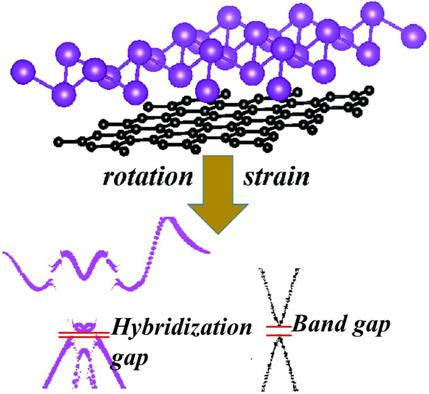当前位置:
X-MOL 学术
›
Phys. Status Solidi. Rapid Res. Lett.
›
论文详情
Our official English website, www.x-mol.net, welcomes your
feedback! (Note: you will need to create a separate account there.)
Tuning the Topological Bandgap of Bilayer‐Bi(111) Supported on Graphene
Physica Status Solidi-Rapid Research Letters ( IF 2.5 ) Pub Date : 2020-05-04 , DOI: 10.1002/pssr.202000131 Zhongyao Li 1 , Zhongyuan Zhang 1
Physica Status Solidi-Rapid Research Letters ( IF 2.5 ) Pub Date : 2020-05-04 , DOI: 10.1002/pssr.202000131 Zhongyao Li 1 , Zhongyuan Zhang 1
Affiliation

|
Based on first‐principles calculations, the electronic structures of the van der Waals heterostructures formed by bilayer‐Bi(111) and graphene are systematically studied. Although the Bi–graphene spacing is larger than 3 Å, the topological bandgap (TBG) of bilayer‐Bi(111) can be tuned by the weak Bi–graphene interaction and the stacking pattern between Bi and graphene. In the zigzag–zigzag stacking pattern, the TBG can be enlarged by reducing the Bi–graphene spacing or the buckling of bilayer‐Bi(111). Interestingly, in the zigzag–armchair stacking pattern, there is a new hybridization gap in a bilayer‐Bi(111) near Fermi level. Meanwhile, the TBG of bilayer‐Bi(111) can also be modified in the heterostructures. However, a large bandgap (more than 100 meV) can be realized in graphene by tuning the Bi–graphene spacing. The calculations suggest the importance of stacking pattern and hybridization on the electronic structures.
中文翻译:

调整石墨烯支持的Bi-Bi(111)的拓扑带隙
基于第一性原理计算,系统地研究了由Bi-111(Bi)-Bi(111)和石墨烯形成的范德华异质结构的电子结构。尽管Bi-石墨烯的间距大于3Å,但Bi-石墨烯(Bi)(111)的拓扑带隙(TBG)可以通过弱的Bi-石墨烯相互作用和Bi与石墨烯之间的堆积模式来调节。在曲折曲折堆叠模式中,可通过减小Bi-石墨烯间距或双层Bi(111)的屈曲来扩大TBG。有趣的是,在曲折扶手椅堆叠模式中,在费米能级附近的双层Bi(111)中存在一个新的杂交间隙。同时,双层Bi(111)的TBG也可以在异质结构中进行修饰。但是,通过调整Bi-石墨烯的间距,可以在石墨烯中实现较大的带隙(大于100 meV)。
更新日期:2020-05-04
中文翻译:

调整石墨烯支持的Bi-Bi(111)的拓扑带隙
基于第一性原理计算,系统地研究了由Bi-111(Bi)-Bi(111)和石墨烯形成的范德华异质结构的电子结构。尽管Bi-石墨烯的间距大于3Å,但Bi-石墨烯(Bi)(111)的拓扑带隙(TBG)可以通过弱的Bi-石墨烯相互作用和Bi与石墨烯之间的堆积模式来调节。在曲折曲折堆叠模式中,可通过减小Bi-石墨烯间距或双层Bi(111)的屈曲来扩大TBG。有趣的是,在曲折扶手椅堆叠模式中,在费米能级附近的双层Bi(111)中存在一个新的杂交间隙。同时,双层Bi(111)的TBG也可以在异质结构中进行修饰。但是,通过调整Bi-石墨烯的间距,可以在石墨烯中实现较大的带隙(大于100 meV)。











































 京公网安备 11010802027423号
京公网安备 11010802027423号